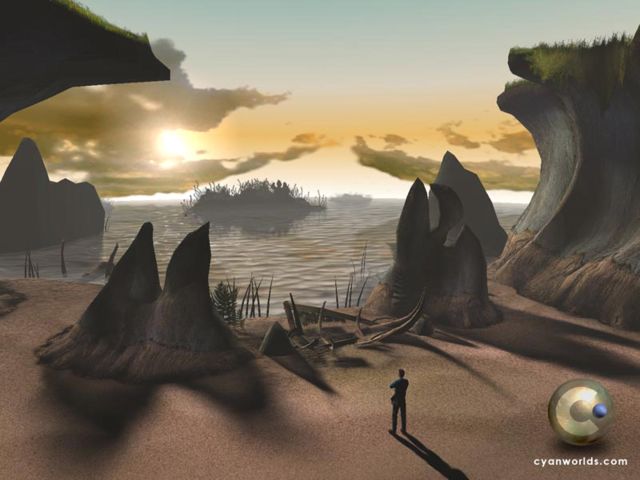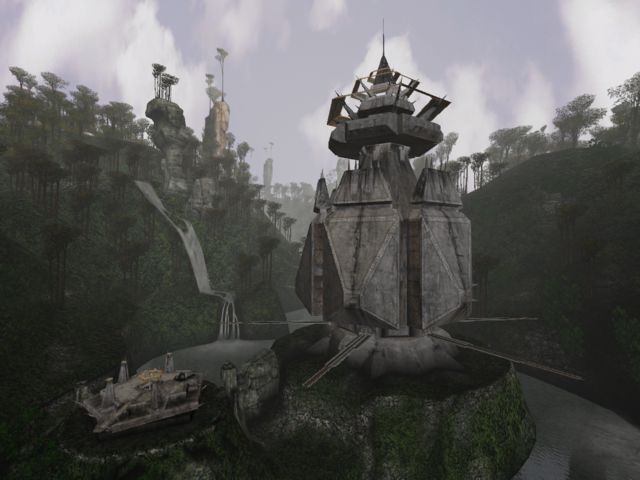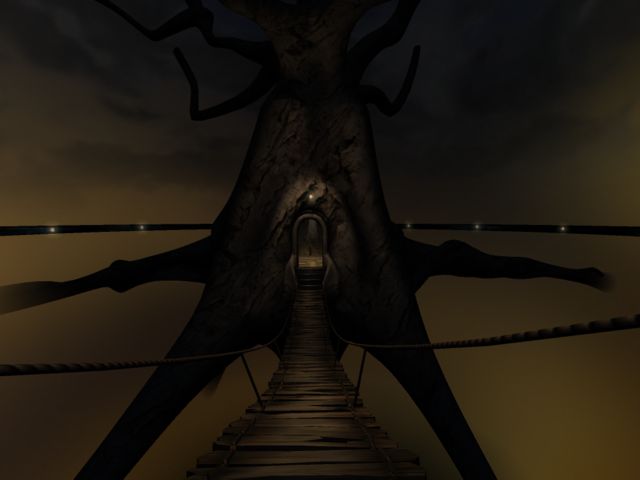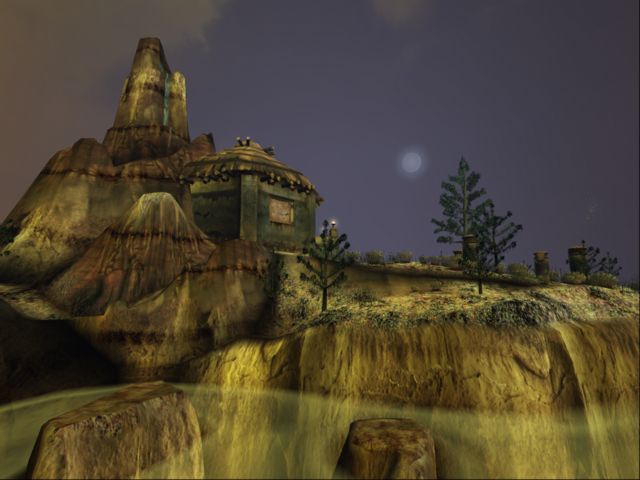|
Uru: The Complete Chronicles
Single-Player and History of the game
The word "Uru" means "city" in Sumerian and also has
a side meaning of "deep", and, of course, anyone who knows our storyline
knows it has to do with that deep city.
- Rand Miller
The official story
of Uru also describes the word "uru" as a D'ni word
meaning "large gathering" or "grand community".
See below for an exploration of Uru's single
player adventure
Uru Product Summaries
Uru: Ages Beyond Myst
Uru Expansion: The Path of the Shell
Uru: The Complete Chronicles
History of Uru
Uru began, we can assume, shortly after Riven in 1998.
It was originally just called 'DIRT' or "D'ni In Real-Time".
This meant that for the first time, players would explore the worlds of
Myst in real-time 3D,with all the advantages of dynamic environments,
swinging camera angles, and go-anywhere gameplay.
Soon, it became known to the public as 'MUDPIE', or "Multiple-User
DIRT Persistent Interactive Environment", a name that would stick
for most of the development, and a name that we Uruites still affectionately
call it from those early days. With the announcement of 'MUDPIE', Cyan
tantalised us with their vision of "One final new world... a world
unlike anything previously possible... a world that will never end."
(- From an early Cyan webpage).
This would be unique. Nobody really knew how an adventure game
would work in the online style of play. Nobody imagined that we would
get a Relto, our own personal age, or that we would be able to collect
and share our own books. We just had faith that Cyan was working on something
marvellous.
Here
you can see some lovely old screenshots, many of which I would still classify
as 'MUDPIE' shots. (Note the filenames). In particular, I think this shot
was a favourite of many Uruites:

Noloben, or the "Linker's Beach" in Mudpie
Sadly, the Age of Noloben never made it into Uru. As Uru
progressed, it changed names again, first to 'Parable', then to simply
'Myst Online', and finally to its official title, Uru: Online Ages
Beyond Myst at the beginning of 2003.
The goal of Uru was to release an initial adventure, then to continue
augmenting the game as the months and possibly years went on. Players
would pay a subscription which would allow them to meet and chat with
other players online, explore their Ages together, and download readily-available
new content, including, periodically, new Ages.
Uru gives us the ability to essentially make a never-ending
story, and I should preface that by saying that for interactive entertainment,
that seems so revolutionary. We're going to make content forever.
We're going to keep making content for Uru so that every time you come
back, you'll find new Ages to explore; new places to go.
- Rand Miller
Then, someone decided to make Uru playable as a single-player
game first, then optionally as a multiplayer game. Whether or not this
optionality doomed Uru Live in the first place, nobody will know,
but certainly the fact that it was a single-player game was the only thing
which saved Uru from a total death. Regardless, the name was changed
to simply Uru: Ages Beyond Myst, and the game was launched initially
as a single-player game in November 2003.
Although Uru Live began as a beta (called "Prologue")
in December, by February, it became clear to Cyan that the number of subscribers
was insufficient. The project was cancelled, and luckily, Uru survived.
To D'ni was released as a free download in March, and The Path
of the Shell followed in June as a purchaseable product.
Finally, on August 5, 2004, the dream of Uru was finally realised.
Cyan put together a package called Untěl Uru, a modified version
of Uru Live, which allowed community sites and individuals to setup
their own servers and allow Uru players to connect and play the
original game together again.
The Single-Player Uru Adventure
With Uru designed as a multiplayer game, many people felt that
the single player was just a shell, a prelude to what never was. I believe
that Uru is a worthy adventure, not as immersive or mysterious
as the original Myst trilogy, but nonetheless a journey through
the Ages on a grand scale.
Unlike previous games, which often featured Ages contained on tiny islands
in an infinite sea, Uru features vast, sprawling Ages, only a small
portion of which the player is allowed to see (in at least four of the
Ages, we can easily see lands beyond the current world). Perhaps Cyan
planned to add to these Ages later. We may never know, but the awe-inspiring
beauty of the Ages is there all the same.

Uru shows us vast lands beyond the scope of the game world.
But more importantly than the Ages is the deep story. Myst, Riven,
Exile and Revelation told the tale of Atrus and his family,
and only gave a glimpse of the empire of D'ni. The Myst Novels
gave us further insight, but nothing as deep as we see in Uru.
Finally, players get to explore the Ages of D'ni, including D'ni itself.
Ages written by D'ni writers, and used by the D'ni. We can read books,
endless tomes of information placed in the game to give keen players further
insight into the worlds of Myst. For the first time, we see the
light and dark sides of D'ni politics - their caste system, their wars,
their struggles, and some more information about their untimely demise*.
The intriguing thing about the Uru story is that, just as promised,
there are three parallel storylines: Past, Present and Future. Each of
the three titles focusses primarily on one of these storylines: Ages
Beyond Myst on the past, To D'ni on the present, and The
Path of the Shell on the future.
The story is presented in a very unfamiliar way. Rather than exploring
the worlds and reading their creator's journals first-hand, as we did
in Myst, we glimpse D'ni through the eyes of two parties. The first
is the DRC, a group who is committed to reconstructing D'ni. Although
we don't directly get to meet any of the DRC, we constantly find their
journals, logbooks, notes and histories lying around. (The typed journals
are a real change from previous games!) Some of these cleverly pull you
into the story of D'ni by unraveling an epic tale, then suddenly tear
you back out to the "present" storyline with a comment by the
translator, such as "Details are a little sketchy on this",
or "This seems like a good place to stop."
We are also given a live link to the past, and to the Myst series
through Yeesha, the eccentric daughter of Atrus and Catherine. She contacts
you at the start, and leaves clues of her own in the form of spoken logs,
and strange "journey cloths" and "link stones" which
aid you on your quest. As the series moves into The Path of the Shell,
Yeesha's role in the game, and in D'ni society, finally becomes clear.
Although many would say the Path of the Shell story is too far
removed from the rest of Uru, I would say that it ties down the
very important character of Yeesha, who never really served much of a
purpose in Ages Beyond Myst.

The secret to Yeesha's destiny lies within this Great Tree
The game's structure is very new to adventure gamers, and swings a little
into the region of RPGs, so its easy to see why it took a long time for
many players to adjust. Particularly, some elements from Diablo II
emerge, with players not being able to save their game - instead returning
to Relto after reloading their character, and having saved links to the
places they've visited.
Many people, once again, have expressed their discontent with this system.
Once again, I feel I must defend it - for one thing, the multiplayer aspect
of the game wouldn't work with a "save/load" feature. But also,
the game has been very cleverly designed to revolve entirely around Relto.
We've come a long way from Myst in which most of the goals were
trying to find a link back to Myst Island. In Uru, the player
carries the Relto book with him or her wherever he or she goes, and can
use it to return home at will. In fact, when in danger from falling, drowning
or other hazards, the avatar automatically links back to Relto.
To this same end, many places in the game will not have any way out,
and you must Relto out. To compensate for this, Uru gives players
"journey cloths" (or in the To D'ni expansion, Nexus
links) all over the game, which allow you to save your place. By this
very free-flowing game design, many new and interesting puzzles revolve
around the use of Relto and the journey cloths themselves. Since you find
yourself returning to Relto once every five minutes or so anyway, there
is clearly no need for a more specific save/load system. (Although personally
I think it would be better if it didn't have to unload and reload an Age
every time you want to Relto out and back.)
The chief complaint about Uru (besides the somewhat bothersome
third-person control scheme) has been the abundance of jumping puzzles.
Myst players have never been able to jump before, so with this
new luxury comes a requirement that we be able to make all sorts of interesting
jumps, which can be seen as good or bad depending on how dextrous you
are.

Relto, the island in the clouds, is the beginning point of every adventure.
One of the strangest things about wandering through Uru alone
is this feeling that everything you see has been made for a multiplayer
environment. Although nothing in the single-player game actually requires
multiple people, there are a number of elements throughout the game that
are, either to promote Uru Live (in Ages Beyond Myst), to remember
Uru Live (in To D'ni) or that were just originally designed for
multiplayer and changed (mostly in Path of the Shell).
Specifically, the entire Age of Gahreesen (pictured above)
seems to be built around this "training wall" - a game in which
two players race to the top of a huge wall maze. This game is in the multiplayer
version, but for someone who only played single-player for the first eight
or so months, the Age seemed rather pointless.
To D'ni, which was released shortly after the closure of Uru
Live contains some deliberate memories of Live. In the single
player expansion, you'll see a list of some of the more popular Live
players, an imager containing screenshots from Live, and the broken
'heek table (another mini-game, playable only in multiplayer). Not to
mention all the devices you get such as the KI and Nexus, which are all
designed to get around and interact with people in the multiplayer environment.
However, with that said, Uru functions surprisingly well as a
single-player adventure. But its eerily lonely once you've ventured online.
Uru can be purchased in one lot called Uru: Complete Chronicles.
This contains all three episodes of Uru, and can be upgraded to
the multiplayer mode, Untěl Uru, for a one-time
cost of just $6 US. Click here to find out more
about multiplayer.
*More information about D'ni, particularly the Fall
can be found in Rand Miller's second Myst novel, Myst: The Book
of Ti'ana.
|